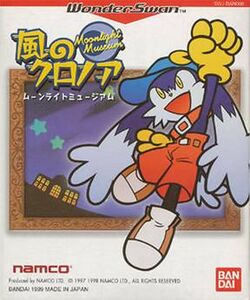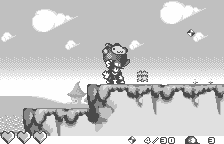Software:Kaze no Klonoa: Moonlight Museum
| Kaze no Klonoa: Moonlight Museum | |
|---|---|
 | |
| Developer(s) | Namco |
| Publisher(s) | Bandai |
| Director(s) | Hideo Yoshizawa |
| Series | Klonoa |
| Platform(s) | WonderSwan |
| Release |
|
| Genre(s) | Platform |
| Mode(s) | Single-player |
Lua error in Module:Lang/utilities at line 332: attempt to call field '_transl' (a nil value). is a video game developed by Namco and published by Bandai, released in Japan for the WonderSwan in 1999. It is the first handheld game in the Klonoa series to place him in a fully two-dimensional world, and established the system that his Game Boy Advance titles later used.
Gameplay
Setting the standard for all the future Klonoa handheld titles, Moonlight Museum displays several standard features for an action sidescroller. The player controls Klonoa as he runs, jumps, and fights his way across several worlds, solving small puzzles in the process. Klonoa defeats enemies by picking them up using a special weapon called the "wind bullet", a ring-shaped object inlaid with a small blue jewel that can fire a small burst of wind straight forward and draw in an enemy, allowing for Klonoa to pick them up over his head. Once he has them, Klonoa can either throw them straight forward, taking out any enemies they happen to hit, or use them to perform a double jump, giving him access to places he otherwise could not reach. Also, by holding the jump button, Klonoa can hover in midair for a short duration by flapping his large ears, which also slightly increases his jump distance.
By completing all five worlds and beating the game, Klonoa can access special bonus stages called "EX Stages".
The game itself is divided into five worlds, each of which is split into six stages called "visions". At the end of each stage, Klonoa must find a door which is unlocked by finding all 3 stars within the vision itself. There are also 30 crystals (or "dream stones") in each vision, collect all these to finish part of the picture shown at the end of the vision (one picture per world). In addition, Klonoa can also find hearts that can replenish his health, as well as 1-up items that look like Klonoa's hat. There are no boss battles in this game.
Story
Taking place sometime before Klonoa, Klonoa's first game, Kaze no Klonoa: Moonlight Museum stars Klonoa and his friend Huepow as they come across a young crying girl who tells them that the moon has been divided into fragments and stolen by a mysterious group of artists that reside in the nearby Moonlight Museum. Determined to help, the duo rush off to the Museum's entrance, and once they come inside, they are greeted by a painter named Picoo who traps them inside a piece of artwork. Klonoa and Huepow must fight their way through five worlds within the Museum itself before finding the source of all their troubles and restoring the moon to the sky.
Development
Moonlight Museum was announced a month before its release in April 1999 as a side-story to the original Klonoa: Door to Phantomile for the PlayStation.[1] The game was in development simultaneously with Klonoa 2 for the PlayStation 2, with the production of both games headed by Hideo Yoshizawa. While the Klonoa 2 team focused more on "action", Moonlight Museum's crew was instructed to focus on the "puzzle" aspect, a trend that would continue for subsequent handheld games in the series.[2]
Reception
| Reception | ||||||
|---|---|---|---|---|---|---|
| ||||||
Kaze no Klonoa: Moonlight Museum entered the Japanese sales charts as the 10th best-selling game during its debut week.[4] In a review of an import version in 2000, IGN called the title "a WonderSwan platformer that's cute, cuddly... and painfully average" finding the level design to be "decent (if not a little dull)" and visuals that didn't push the limits of the handheld. The website remarked that the title could be played equally well on the WonderSwan's horizontal or vertical display modes, and the audio was "decidedly above-average" despite limited background music.[3]
Notes
References
- ↑ Mielke, James (1999-04-08). "Klonoa: Moonlight Museum". GameSpot. http://www.gamespot.com/news/klonoa-moonlight-museum-2451557. Retrieved 2013-04-27.
- ↑ Parish, Jeremy (2012-09-20). "Champion of Dreams: An Interview with Hideo Yoshizawa". 1UP.com. Archived from the original on 2013-02-23. https://web.archive.org/web/20130223212713/http://www.1up.com/features/champion-dreams-interview-hideo-yoshizawa. Retrieved 2013-03-27.
- ↑ 3.0 3.1 Williamson, Colin (2000-04-13). "Klonoa: Moonlight Museum (Import)". IGN. http://www.ign.com/articles/2000/04/14/klonoa-moonlight-museum-import. Retrieved 2008-11-04.
- ↑ Carless, Simon (1999-06-11). "Dreamcast Desperation?". Gamasutra. Archived from the original on 2008-06-24. https://web.archive.org/web/20080624133802/http://www.gamasutra.com/newswire/mgt_report/19990611.htm. Retrieved 2008-10-31.
External links


